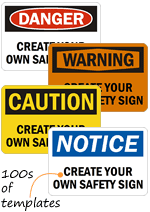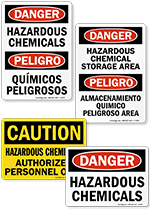Protecting workers from forklift hazards is the key responsibility of employers. Training workers on how to operate forklift trucks safely and how to avoid accidents are often crucial parts of a safety program. A few years ago - a punch press operator at a computer component manufacturing unit paid the price of an unsafe workplace when she was fatally injured by a reversing forklift truck at high speed; right in her direction. Is it the fault of an untrained forklift driver or simply negligence towards workplace safety?
When dealing with powered industrial trucks like heavy forklifts the onus lies on the management to provide a safe and healthy workplace. No stones can be left unturned. In many of the cases the immediate blame of an accident is pinned on the forklift driver. However, upon closer examination, the lack of proper training to the workers emerges as a key factor of accidents. By installing forklift signs you can keep your employees constantly reminded of the hazards of the workplace.
Common Forklift accidents
An OSHA publication poses some serious figures – Approximately 95,000 employees every year are injured while operating powered industrial trucks. From nearly 100 fatal accidents, forklifts contribute to a significant amount. Most common forklift accidents include forklift overturns, pedestrian workers struck by the forklifts, victims crushed by forklifts and falls from forklifts.
If attention had been paid to details, most of these accidents could have been avoided by adhering to safety procedures and by installing Forklift Signs. It is essential to drive forklifts under pre-defined rules. If the driver in question from the above incidence had followed the rules of slow speed, stopping and blowing the horn; a life could have been saved. OSHA places high importance to forklift related accidents and issues strict requirements for anybody who will operate the forklifts.
Importance of Forklift Signs
Forklift signs are safety reminders at workplace. They can help underline the importance of following safety rules without fail. Posting Forklift Signs is a reliable way to decrease accidents resulting from an ignorant or untrained mind. Even for a beginner, these Forklift Signs are a guiding factor to learn safe forklift operating measures.
The highest authority on occupational safety, OSHA, understands the need of fostering safety in the workplace. It recommends the plant safety managers to post various Forklift Signs for speed limit, traffic control, battery operations, and more.
Some great options for Forklift Signs include the ‘Look Out for Forklift Signs’ that forewarn employees to practice caution in areas expecting high forklift activity. Forklift Signs with ‘Caution, Forklift Traffic’ also help ensure the safety of workers on foot by reminding them to stay off the forklift tracks. In an ideal scenario, pathways should be separate for foot traffic and forklifts so that people know of the safe zones. Pedestrian Only Forklift Signs can be placed to indicate that one can traverse in a particular lane without any fear.
Similar type of forklift warning signs all over the facility may compromise the required effect. A well blended approach of posting several styles of Forklift Signs instead will help accomplish maximum impact. A healthy mix of Forklift Floor Signs such as SlipSafe™ Floor Signs, FloorBoss™ Fold Up Signs and Reusable Floor Stencils can be adopted to engage workers time and again.
SlipSafe™ Forklift Signs are made of premium quality slip resistant vinyl that includes pebble texturing for better safety in high-traffic areas. Wearing-off easily is not an option. Enjoy the no-hassle pasting with permanent acrylic adhesive backed by a peel-off liner.
In the context of warehouses or factories, the Forklift Signs are no less relevant than hi-tech equipment for safety. These simple but very effective forklift signs work silently in the background. They assist considerably in enforcing safe forklift driving practices like stopping at stop signs, obeying speed limits, slowing down and blowing the horn at respective intersections; guarding many more lives than we can possibly imagine.












